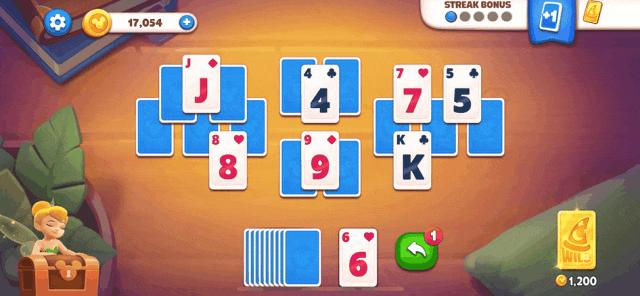
Read More《月流水1.6亿,这个休闲玩法在海外又出现爆款了》
Positive Reviews: A Game-Changer in the Solitaire Genre, a Double Victory of IP Empowerment and Mature Models
The huge success of Disney Solitaire has injected new vitality into the long-silent Solitaire genre. Its success is the result of the resonance of multiple factors and has important implications for the overseas expansion of casual games.
First of all, the support of the Disney IP is the core engine for it to break through geographical limitations and quickly gain popularity. The revenues of traditional Solitaire games such as Solitaire Grand Harvest and Tiki Solitaire Tripeaks are concentrated in the European and American markets (accounting for over 80%), while Disney Solitaire, thanks to Disney’s strong influence in the Japanese market (Japan accounts for 15% of the cumulative revenue), has become one of the few casual games that are popular in both the East and the West. This breakthrough verifies the key role of IP in cross – cultural market penetration – Disney’s classic characters (such as those in Toy Story and The Little Mermaid) directly touch the emotional resonance points of Japanese players through advertising materials, reducing the cognitive threshold for users and opening up new growth markets for the Solitaire genre.
Secondly, Superplay’s precise replication of the mature gameplay model has significantly reduced the trial – and – error cost of incubating blockbusters. From Domino Dreams to Disney Solitaire, Superplay has continued the core design of “Solitaire gameplay + item system + entry fee mechanism + consecutive elimination rewards”: the functions of items such as undo, wild cards, and additional cards are reused; gold coins are the core resource for controlling content consumption, and the multiplier system stimulates users to pay… This “blockbuster replication” strategy is not a simple transplantation of gameplay, but is based on a deep understanding of user behavior – players already have an understanding of the mild and easy – to – learn Solitaire gameplay. Reusing mature mechanisms can quickly establish user habits. At the same time, by adjusting details (such as Disney Solitaire deleting furniture selection and plot and focusing on the creation of levels and scenes), the experience is optimized and the monetization efficiency is improved.
Moreover, the “light optimization” of the Tripeaks Solitaire gameplay in Disney Solitaire accurately grasps user needs. Compared with traditional card Solitaire, its rules are simplified (there is no restriction on suits or order, only adjacent card values are required), which reduces the learning threshold; special levels (puzzles, additional cards, card transformation) and consecutive elimination rewards (gold coins, wild cards) add randomness and fun while maintaining strategic elements. For example, eliminating 4 – 6 cards in a row can trigger a reward, and the design of “only one card away from getting a reward” cleverly uses the user’s “loss aversion” psychology, prompting them to pay for items. This “light but not shallow” gameplay design not only meets the “filling of fragmented time” needs of casual players but also improves user stickiness through mild strategic elements.
Finally, the refined design of the economic system has significantly increased the revenue – generating ability. As the core resource, gold coins form a “resource cycle” through hourly offline rewards outside the game (the amount is slightly higher than the level entry fee) and multiple in – game acquisition methods (rewards for successfully clearing levels, consecutive elimination rewards, and settlement of remaining cards), which not only ensures the basic activity of users but also magnifies resource consumption and rewards through the multiplier system (1/2/4 times), creating a “sense of resource scarcity” and driving users to pay for items or increase the multiplier. This closed – loop design of “reward – consumption – payment” is similar to the Bingo gameplay and effectively improves the ARPU (average revenue per user) of users.
Negative Reviews: Hidden Worries Behind the Blockbuster, Double Challenges of Innovation and Sustainability
Although Disney Solitaire has shown excellent short – term performance, its model still has potential risks, and we need to be vigilant about the “blockbuster dependence syndrome” and the uncertainty of the long – term lifecycle.
Firstly, the lack of gameplay innovation may lead to user aesthetic fatigue. In essence, Disney Solitaire is an “optimized replication” of Tripeaks Solitaire rather than a disruptive innovation. Its core mechanisms (adjacent card value elimination, item system, gold coin economy) are highly similar to those of Solitaire Grand Harvest and Domino Dreams, and differentiation is only achieved by deleting the plot and strengthening the IP theme. This “minor innovation” can quickly attract users in the short term, but in the long run, if there is a lack of content updates (such as new gameplay mechanisms and in – depth social functions), users may get tired of “repeatedly clearing levels”. Historically, Solitaire Home Design by Beta Technology saw a rapid decline in revenue due to its single gameplay. If Disney Solitaire fails to continuously launch new levels or functions, it may follow the same path.
Secondly, over – dependence on IP may limit independent competitiveness. The strong appeal of the Disney IP is the key for Disney Solitaire to break through the situation, but the cost of IP licensing is high, and there is uncertainty in the cooperation with external IPs (such as the expiration of the license and the strategic adjustment of the IP owner). In contrast, Fishdom Solitaire by Playrix relies on its own IP (Fishdom), and Grandma’s Solitaire Secrets by Meracore is associated with Merge Mansion, both of which reduce risks through internal IP linkage. If Disney Solitaire over – depends on external IPs, it may face the problem of “being too deeply bound to the IP” in the future – users stay because of the IP rather than their recognition of the game itself. Once the popularity of the IP declines or the cooperation terminates, the risk of user loss will increase significantly.
Thirdly, the intensifying market competition may compress the profit margin. The success of Disney Solitaire has prompted other game manufacturers to follow suit: Candy Crush Solitaire by King and Fishdom Solitaire by Playrix are all trying the “IP + Solitaire” model. As more products enter the market, the cost of user acquisition in the Solitaire genre will increase, and user diversion is inevitable. For example, although Candy Crush Solitaire currently performs worse than Disney Solitaire, its “reserve card area” mechanism adds depth to the gameplay (allowing repeated use of bottom cards), which may attract users who prefer strategy. If it optimizes the experience in the future, it may pose a challenge to Disney Solitaire.
Fourthly, the long – term test of user retention has not been passed. Currently, the monthly revenue of Disney Solitaire reaches 160 million yuan, but the “blockbuster lifecycle” of casual games is usually short (for example, it took Domino Dreams two years to stabilize at ranks 50 – 80 on the best – selling list). The Solitaire gameplay itself is of the “mild and repetitive” type, and users may leave because of “no new content after clearing all levels” or “increased difficulty in obtaining gold coins”. Although the multiplier system has delayed this problem, how to maintain user activity through continuous content updates (such as launching themed levels in collaboration with new Disney movies and adding social interaction functions) remains a long – term challenge.
Advice for Entrepreneurs: Seize the Solitaire Opportunity and Balance the “Dual – Wheel Drive” of Innovation and IP
The huge success of Disney Solitaire provides a clear direction for the overseas expansion of the Solitaire genre. Entrepreneurs can start from the following aspects:
IP Strategy: Make Good Use of Self – Owned IPs or Strong Licenses to Reduce Market Education Costs
If you have a self – owned IP (such as the “grandma” IP in Merge Mansion) or a strongly licensed IP (such as Disney), you can give priority to the “IP + Solitaire” model and use the user base of the IP to quickly open up the market. If you don’t have a high – quality IP, you need to make breakthroughs in gameplay innovation (such as the “reserve card area” mechanism in Candy Crush Solitaire) and establish a competitive advantage through differentiated gameplay.Gameplay Design: “Light but Not Shallow”, Balance the Threshold and Depth
The core advantage of Solitaire is its “low threshold”, but it is necessary to avoid “monotonous gameplay” caused by excessive simplification. You can learn from the special levels (puzzles, card transformation) and consecutive elimination reward designs in Disney Solitaire to add strategic elements and randomness while reducing the learning cost; you can also try to incorporate mild narratives (such as the plot in Grandma’s Solitaire Secrets) or social functions (such as friend – to – friend level – clearing PK) to improve user stickiness.Economic System: Precisely Control the Resource Cycle to Improve Monetization Efficiency
Use gold coins as the core resource and design multiple acquisition methods “outside and inside the game” (such as timed offline rewards, consecutive elimination rewards, and settlement of remaining cards) to ensure the basic activity of users; at the same time, create a “sense of resource scarcity” through the multiplier system and item payment points (such as wild cards, additional cards) to drive payment conversion. It is necessary to balance the speed of resource acquisition and consumption to avoid user loss due to “excessive grinding” or “high payment pressure”.Market Expansion: Focus on Localization and Tap the Potential of Emerging Markets
Traditional Solitaire games rely on the European and American markets. You can learn from the IP advantage of Disney Solitaire, study the user preferences of emerging markets such as Japan and Southeast Asia (such as the high acceptance of Disney IPs by Japanese users), and expand the market through localized materials (such as using locally popular IP characters) and operations (such as festival – themed events) to reduce dependence on a single market.Content Update: Continuously Invest to Extend the Product Lifecycle
The lifecycle of casual games highly depends on content updates. You need to regularly launch new levels, themes (such as collaborations with popular movies/IPs), and functions (such as social interaction, leaderboards) to avoid user loss due to “content exhaustion”. At the same time, pay attention to user feedback and optimize gameplay details (such as level difficulty, item prices) through A/B testing to keep users fresh.
In summary, the success of Disney Solitaire is not only a breakthrough in the Solitaire genre but also provides a reference path of “IP empowerment + replication of mature models” for the overseas expansion of casual games. However, entrepreneurs need to be vigilant about the risks of “lack of innovation” and “IP dependence”. Only through gameplay optimization, economic system design, and continuous content investment can short – term blockbusters be transformed into long – term products.
- Startup Commentary”Building LLMs: The Knowledge Graph Foundation Every AI Project Needs”
- Startup Commentary”The 17th Year of Tmall Double 11 and the New Map Rewritten by AI”
- Startup Commentary”How to Prepare Your Data for Artificial Intelligence”
- Startup Commentary”Small and Medium-sized Banks: “Cutting the Tail” in Loan Assistance”
- Startup Commentary”The Six AI Giants on Stage: AGI Is No Longer a “Future” Thing”





